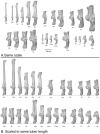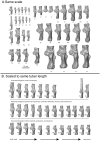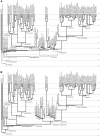Evolution and allometry of calcaneal elongation in living and extinct primates
- PMID: 23844094
- PMCID: PMC3701013
- DOI: 10.1371/journal.pone.0067792
Evolution and allometry of calcaneal elongation in living and extinct primates
Erratum in
- PLoS One. 2013;8(9). doi:10.1371/annotation/77784e61-3a43-4615-85bd-b6b4369568fd
Abstract
Specialized acrobatic leaping has been recognized as a key adaptive trait tied to the origin and subsequent radiation of euprimates based on its observed frequency in extant primates and inferred frequency in extinct early euprimates. Hypothesized skeletal correlates include elongated tarsal elements, which would be expected to aid leaping by allowing for increased rates and durations of propulsive acceleration at takeoff. Alternatively, authors of a recent study argued that pronounced distal calcaneal elongation of euprimates (compared to other mammalian taxa) was related primarily to specialized pedal grasping. Testing for correlations between calcaneal elongation and leaping versus grasping is complicated by body size differences and associated allometric affects. We re-assess allometric constraints on, and the functional significance of, calcaneal elongation using phylogenetic comparative methods, and present an evolutionary hypothesis for the evolution of calcaneal elongation in primates using a Bayesian approach to ancestral state reconstruction (ASR). Results show that among all primates, logged ratios of distal calcaneal length to total calcaneal length are inversely correlated with logged body mass proxies derived from the area of the calcaneal facet for the cuboid. Results from phylogenetic ANOVA on residuals from this allometric line suggest that deviations are explained by degree of leaping specialization in prosimians, but not anthropoids. Results from ASR suggest that non-allometric increases in calcaneal elongation began in the primate stem lineage and continued independently in haplorhines and strepsirrhines. Anthropoid and lorisid lineages show stasis and decreasing elongation, respectively. Initial increases in calcaneal elongation in primate evolution may be related to either development of hallucal-grasping or a combination of grasping and more specialized leaping behaviors. As has been previously suggested, subsequent increases in calcaneal elongation are likely adaptations for more effective acrobatic leaping, highlighting the importance of this behavior in early euprimate evolution.
Conflict of interest statement
Figures











Similar articles
-
Evolution of postural diversity in primates as reflected by the size and shape of the medial tibial facet of the talus.Am J Phys Anthropol. 2015 May;157(1):134-77. doi: 10.1002/ajpa.22702. Epub 2015 Feb 14. Am J Phys Anthropol. 2015. PMID: 25682740
-
Astragalar and calcaneal morphology of the middle Eocene primate Anchomomys frontanyensis (Anchomomyini): Implications for early primate evolution.J Hum Evol. 2016 Feb;91:122-43. doi: 10.1016/j.jhevol.2015.08.011. Epub 2016 Jan 12. J Hum Evol. 2016. PMID: 26852816
-
Functional morphology of the hallucal metatarsal with implications for inferring grasping ability in extinct primates.Am J Phys Anthropol. 2015 Mar;156(3):327-48. doi: 10.1002/ajpa.22652. Epub 2014 Nov 5. Am J Phys Anthropol. 2015. PMID: 25378276
-
Hands of early primates.Am J Phys Anthropol. 2013 Dec;152 Suppl 57:33-78. doi: 10.1002/ajpa.22392. Am J Phys Anthropol. 2013. PMID: 24249591 Review.
-
New pedal remains of Megaladapis and their functional significance.Am J Phys Anthropol. 1996 May;100(1):115-39. doi: 10.1002/(SICI)1096-8644(199605)100:1<115::AID-AJPA11>3.0.CO;2-3. Am J Phys Anthropol. 1996. PMID: 8859959 Review.
Cited by
-
Predictive Simulations of Musculoskeletal Function and Jumping Performance in a Generalized Bird.Integr Org Biol. 2021 Apr 15;3(1):obab006. doi: 10.1093/iob/obab006. eCollection 2021. Integr Org Biol. 2021. PMID: 34377939 Free PMC article.
-
Including Distorted Specimens in Allometric Studies: Linear Mixed Models Account for Deformation.Integr Org Biol. 2021 May 18;3(1):obab017. doi: 10.1093/iob/obab017. eCollection 2021. Integr Org Biol. 2021. PMID: 34377943 Free PMC article.
-
Oldest ctenodactyloid tarsals from the Eocene of China and evolution of locomotor adaptations in early rodents.BMC Evol Biol. 2018 Oct 4;18(1):150. doi: 10.1186/s12862-018-1259-1. BMC Evol Biol. 2018. PMID: 30286712 Free PMC article.
-
Effects of binocular cue availability on leaping performance in Cheirogaleus medius: implications for primate origins.J Exp Biol. 2024 Feb 15;227(4):jeb245434. doi: 10.1242/jeb.245434. Epub 2024 Feb 22. J Exp Biol. 2024. PMID: 38348492 Free PMC article.
-
Interspecific scaling patterns of talar articular surfaces within primates and their closest living relatives.J Anat. 2014 Feb;224(2):150-72. doi: 10.1111/joa.12137. Epub 2013 Nov 13. J Anat. 2014. PMID: 24219027 Free PMC article.
References
-
- Le Gros Clark WE (1959) The Antecedents of Man. Edinburgh: Edinburgh University Press. 394 p.
-
- Cartmill M (1992) New views on primate origins. Evol Anthropol 1: 105–111. - PubMed
-
- Szalay FS, Dagosto M (1980) Locomotor adaptations as reflected on the humerus of Paleogene primates. Folia Primatol 34: 1–45. - PubMed
-
- Crompton RH (1995) “Visual predation,” habitat structure, and the ancestral primate niche. In: Alterman L, Doyle GA, Izard MK, editors. Creatures of the Dark: The Nocturnal Prosimians. New York: Plenum Press. 11–30.
-
- Napier JR, Walker AC (1967) Vertical clinging and leaping - a newly recognized category of primate locomotion. Folia Primatol 6: 204–219. - PubMed
Publication types
MeSH terms
LinkOut - more resources
Full Text Sources
Other Literature Sources
Research Materials

